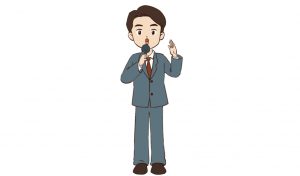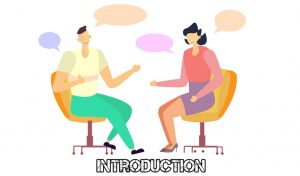How To Start a Speech (With Examples): A speech is a discussion presented to an audience, whether informal or official. Giving a speech allows you to speak to a group of people and share your ideas and, more often than not, your opinions. Speeches may be found in a variety of settings and for a variety of reasons. Public speaking is a wonderful art form, and it may be even better when the speaker has a goal in mind.
The speech writing process becomes simpler and smoother when you have a defined target and purpose in mind. While anybody can deliver a speech, having the appropriate goal and a broad awareness of the surroundings and your audience may help make it more successful. Some speeches are intended to educate, while others are intended to entertain.

Recommended: Best ways to start a debate (Introducing yourself)
Components of a Speech
It’s time to compose the speech with an introduction, body, and conclusion once you’ve studied your audience, chosen a topic, gathered supporting resources and developed an outline. The broadcaster’s maxim is followed in these important parts:
(1) Let them know what you’re about to say.
(2) Inform them.
(3) Inform them of what you’ve said.
a. The Introduction: Tell them what you’re about to say: A strong opening grabs the audience’s attention, previews the topic and important ideas, and establishes your authority as a speaker. Employing a quotation, telling a tale, raising questions, presenting comedy, using surprising facts or figures, offering an illustration or anecdote, and mentioning historical or contemporary events are all effective methods to draw attention.

The introduction directs the audience’s attention to the most important elements. The impact of your speech, which is generally saved for the end, should be added at the beginning of the speech, according to science communicators. The opening establishes your trustworthiness with the audience: They’re curious as to why they should believe what you’re saying. As a result, establishing oneself is essential. The opening establishes your trustworthiness with the audience: They’re curious as to why they should believe what you’re saying. As a result, establishing oneself is essential.
Also see: How to speak in public without fear or anxiety
b. The Body: You will include reliable sources, such as scientific papers, in the body of the speech and refer to them throughout the speech. The key concepts of the speech should flow organically from the speech’s goal and thesis statement in this section.
It’s ideal to limit your content to two to five key points, with a maximum of seven.
Focusing on three major issues is recommended by scientists’ communicators for scientific talks. If you have too many, your viewers will forget your main points. Focusing on three main ideas and providing solid supporting reasons for each of them can help your speech be remembered. Supporting points to aid in the development of your thesis and the justification of your main statements.
c. Conclusion: The conclusion sums up what the audience was expected to learn or be convinced to do throughout the presentation. Key phrases such as “finally,” “let me end by stating,” and “in conclusion” might be used to indicate that the conclusion is near. Because the conclusion is your last chance to inspire your audience, it should conclude with a powerful remark.
A good finish for a persuasive speech is a call to action, in which you tell the audience what they should do with what they’ve learned. Many times, a mirrored conclusion can be used, which refers back to, or “mirrors,” the information you present in the introduction.
Recommended: Interesting ways to end you debate presentation

Best and Impactful Ways to start a speech Presentation
1. Quote: Using a famous or relatable quote to begin a speech is one way to capture the audience’s attention. If you’re giving a speech about politics, for example, you could use a powerful quote that communicates a central political theme to connect with the subject of your speech. Starting your speech with a quote can also help to engage the audience and get them thinking about what you’re saying.
People love quotes because they are motivating and inspiring, as well as easy to remember. The well-considered words of history’s greatest orators can sometimes be the difference between a successful speech and one that fails.
For example, “If your actions inspire others to dream bigger, learn more, do more, and grow bigger, you’re a leader.”
Also see: Best education system in the world
2. Question of Rhetoric: A rhetorical question is an effective spoken communication tactic. These questions will help you engage and engage your audience in your presentation. They aid in the regulation of your words and the thinking of the audience.
A competent public speaker knows how to get his audience to take action on his message.
For example, “If you prick us, do we not bleed?” is a famous rhetorical question posed by William Shakespeare. Do we not laugh if you tickle us? Do we not perish if you poison us? And if you wrong us, aren’t we entitled to retaliation?
3. Introduce in a straightforward manner: Another popular and efficient technique is to begin your speech with a brief introduction that leads into a forceful remark. For example, a speech about the rising earthquakes in a small town caused by fracking may benefit from a short start.

They may start their speech by telling how they grew up in a tiny community before moving on to a powerful message on the effects of fracking. The goal of using the short beginning strategy is to utilize it as a springboard for a compelling, thought-provoking, or otherwise persuasive remark that communicates your speech’s theme.
Recommended: How to become a good conversationalist
4. Thank the Organizers and the Attendees: If you want to adhere to the basics of public speaking, simply thank the persons who made your presentation possible. Thanking the event organizers and the audience complements them, makes them pleased and delighted to have you there, and establishes a strong connection between you and the audience.
Refer to the individual who introduced you to one or more of the organization’s top executives in the audience, and congratulate them as a sign of respect. In your complimentary remarks to the company, be humble and honest.
5. Scenario: Using a “what if” scenario to pique the audience’s interest in your speech works like a charm. To elicit your audience’s imagination, begin your speech with a “what if” question.
“What if you had been blind all your life and just got to see the world today?” for example. So far, how have you visualized the world? And what draws you to these hues? Is there anyone who is colorblind, by the way?”
Also see: How to start a conversation with someone for the first time
6. This day in history: One of the key reasons why people assemble to listen to talks is to learn something. The audience will immediately pay attention if you begin your speech with a historical fact.

If your speech occurs on March 5, for example, you may begin by saying, “On this day, March 5, 1963: Arthur “Spud” Melin, co-founder of Wham-O, patents the Hula Hoop, a hip-swiveling toy that became a big phenomenon across America when it was first released by Wham-O in 1958.” In the first four months of manufacture, an estimated 25 million Hula Hoops were sold.”
7. Anecdote or Experience: To make your audience feel connected, begin your speech by sharing personal stories. You might start by telling them how much you think they’ll appreciate what you’re going to show them.
“I first fell in love while I was in high school.”, for example. From infancy and childhood, people have a strong need for tales of all kinds. People sit down, get quiet, and lean forward like kids around a campfire as soon as they discover you’re about to tell a story.
Also see: How to introduce a Guest in an event
8. Silence: Pauses are the most valuable aspect of talks. Silence, when used well, has greater eloquence than words. When you need to highlight anything, take a little pause. Knowing when to take a breather might help you deliver your message more effectively.
9. Make up a tale: You might also tell a tale to start your speech. The storytelling technique can help you develop audience anticipation and get them thinking about how your narrative will relate to the issue. Consider the case of an honors graduate who delivers a speech at a graduation ceremony.
The graduate might utilize narrative to capture the audience’s attention and engage them in the presentation. Similarly, narrating a tale elicits emotional responses from the audience as they listen, which may greatly engage them and make them invested in what you’re saying.
“Once upon a time” is one of the most potent words that may quickly attract the audience’s attention since people of all ages like stories of all kinds.
Also see: How to hold a long conversation with a girl
10. Statistics: Start your speech with fascinating and original information that will wow your audience. Incorporating statistics into your presentation is an excellent way to give your message a quantitative and persuasive edge. It provides a basis for you to build your argument, defend your claim, and demonstrate your position.
Giving figures in your beginning might be as simple as saying, “In 2021, there were 12,000 homeless people strolling the streets of California.” By 2023, the number is expected to nearly quadruple.” This form of messaging highlights the need to tackle the problem of homelessness since the number is persuasive, detailed, and alarming.
11. Make a joke: To engage the audience, you may crack a joke or employ a comedic technique. Telling a joke or engaging in light-hearted banter with your audience might help you connect with the folks in the crowd.
This may have a significant influence on how attentive the audience is when you introduce your speech’s topic. Additionally, for positive-themed presentations and speeches, delivering a joke or making the audience laugh might be useful. Making jokes at the start of your presentation informs the audience that you aren’t too serious and that they can relate to you.
For example, a good beginning maybe, “If you can hear me, please start clapping to baffle those who can’t hear what I’m saying.”
Recommended: Best approach to handle inferiority complex
12. The challenge open: Audiences want to be challenged and inspired to participate in a cause that they care about. If you’re trying to boost sales, raise money for a project, recruit volunteers, or change legislation, start your speech with a challenge. It’s not enough to believe in your message; you must also act on it.
You may start your speech with “Leaders see potential where followers see difficulties, I’m here today to urge officials to persuade individuals who are skeptical of the project to see past the roadblocks in the development of this local park and consider providing a better environment for citizens.”
Recommended: How to avoid falling in love with someone
Conclusion
Knowing how to begin a presentation or speech is one of the most difficult aspects of public speaking. The first sentence of a presentation leaves an effect on the audience. Each speech should include three key sections: an introduction, a body, and a conclusion. You should outline before writing the speech. An outline is a structure that arranges the major and supporting elements in the order that you feel will have the most impact on your audience.

Edeh Samuel Chukwuemeka, ACMC, is a lawyer and a certified mediator/conciliator in Nigeria. He is also a developer with knowledge in various programming languages. Samuel is determined to leverage his skills in technology, SEO, and legal practice to revolutionize the legal profession worldwide by creating web and mobile applications that simplify legal research. Sam is also passionate about educating and providing valuable information to people.